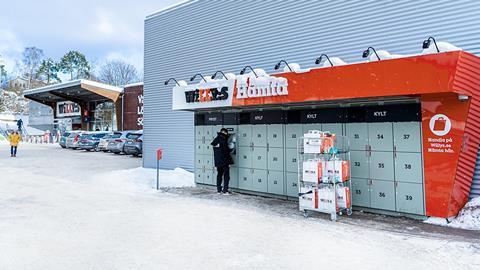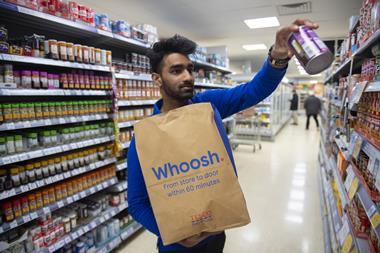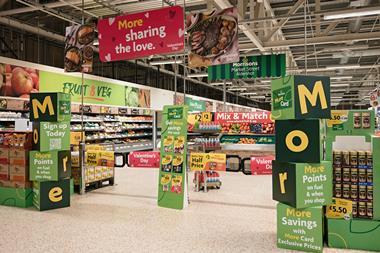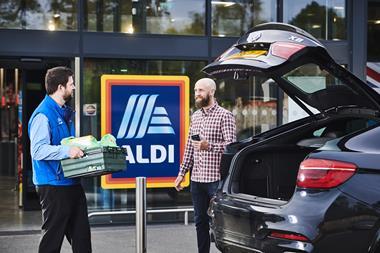With household budgets tightening, how can grocery retailers maximise e-commerce profitability? Strongpoint CEO Jacob Tveraabak writes that now is the time to invest in click-and-collect grocery lockers to capture and retain market share.
Grocery retailers face unprecedented pressure: a new faster and more dynamic competitive landscape, the price of food shooting up, pressure from discounters, labour costs rising and inflation increasing across the board. Add to that the pressure to go online, maintain and increase market share while customers are tightening their belts. And if that wasn’t enough, grocery retailers are finding it harder and harder to recruit and retain staff.
Grocery retailers need to save costs, anywhere and everywhere. If you can find an efficiency saving, you should be leveraging it. And in the world of e-commerce, there are a lot of costs, from picking to the last mile.
But there is one region where the pressures are even higher than in the UK, with far higher labour costs: Scandinavia. Swedish grocery retailers face similar pressures as their UK counterparts, but have always had to factor in far higher labour costs, sometimes two to three times greater.
So, what are Swedes doing differently to the Brits? Because when it comes to grocery e-commerce the two regions present a very different landscape.
Firstly, Sweden has managed to strike a balance between home deliveries and click-and-collect; these are now roughly equal with a 50-50 split[1]. The UK, however, is still predominantly a home delivery market, yet its potential to navigate new customers to click-and-collect, as well as converting existing customers, is vast.
Secondly, Sweden has pushed its click-and-collect customers to do what millions of people already do in-store: self-service. But not just their in-store purchases, also in their e-commerce orders. According to our insights, Sweden has the highest concentration of self-service temperature-controlled grocery lockers in the world.
In 2022, grocery lockers made the front page of Sweden’s leading business daily newspaper. The article revealed how using grocery lockers at scale was key to achieving profitability in grocery e-commerce for the country’s “leading discount grocery chain”.
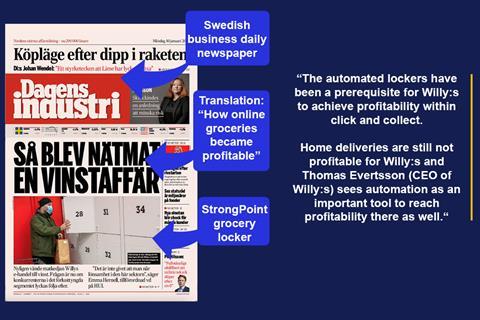
So, what’s their secret? And why haven’t UK grocery retailers followed suit?
Firstly, the cost-saving benefits for grocery retailers are significant – when scaled. This is due mainly to the speed of processing orders compared to other last-mile options. It takes just one minute to load a grocery locker order. Scale that over 1,000 stores and that amounts to over 400,000 orders per day, with just one day’s labour cost per store. And that’s a very easy minute of work. From our insights, a very common feedback from store managers is that their staff love the lockers because they make their job easier, faster and simpler.
Secondly, lockers can be placed almost anywhere, meaning they can be used in any store in any location and – most importantly – at any time.
Thirdly – and this is the most important lesson – because lockers allow grocery retailers greater revenues, they can plough some of this back into marketing and promotion to increase the number of grocery lockers for customers. This creates a positive loop of decreasing costs and higher profitability. But you don’t have to use all the additional revenue streams just to channel customers towards click-and-collect; a percentage can be earmarked to boost overall profitability or even be more competitive on prices.
To give an example – one store in Sweden using a grocery locker set-up of 60 compartments (a mixture of frozen and chilled) can process over 200 orders per day through the grocery lockers alone. That means a UK grocery retailer using grocery lockers across 1,000 stores, could process over 200,000 orders per day with grocery lockers alone, saving enormously on labour and delivery costs.
The benefits for customers are also vast. It takes less than one minute to pick up an order from a locker, making it by far the fastest way to collect groceries. Grocery lockers can be available 24/7 and can be placed almost anywhere, making them the most convenient and accessible of all click-and-collect options. In Scandinavia, grocery retailers are also deploying mobile lockers in popular tourist locations to serve seasonal demands, or even making use of them at big events.
In the UK, many grocery retailers, even before the pandemic, have trialled grocery lockers. In the pre-pandemic world of low-volume orders, it perhaps didn’t catch on. But lessons from Sweden show that UK grocery retailers can also turbocharge profitability at scale. And this is the point – at scale.
If you have never considered grocery lockers, you should. If you have in the past and you didn’t see the uptake or couldn’t achieve your return on investment, you should look into the Swedish experience and learn from how they have scaled the solution and leveraged it to cut costs and boost profitability.
There are no short-cuts to achieving this, but with grocery lockers retailer have huge opportunities to lock in long-term profitable customers at speed and scale in almost any store, anywhere. Other grocery retailers are already doing it – can you afford not to take a look, or, a second look?
For more information on how grocery retailers are leveraging StrongPoint’s grocery lockers please visit StrongPoint’s website: https://www.strongpoint.com/order-fulfillment/click-collect-lockers/ or send an email to our head of UK sales Tim Wheeler on tim.wheeler@strongpoint.com
Author: Jacob Tveraabak, StrongPoint CEO
Jacob Tveraabak has over 20 years’ experience in the grocery retail industry, including more than a decade as a retail specialist at McKinsey, and has headed up business development at one of the biggest grocery retailers in the Nordics. In addition, he co-founded a P2P car sharing platform company and was a board member of the international online grocery retailer Oda.
Source
1 https://www.svenskdagligvaruhandel.se/wp-content/uploads/Dagligvaruindex-juni-2022-ENG.pdf








